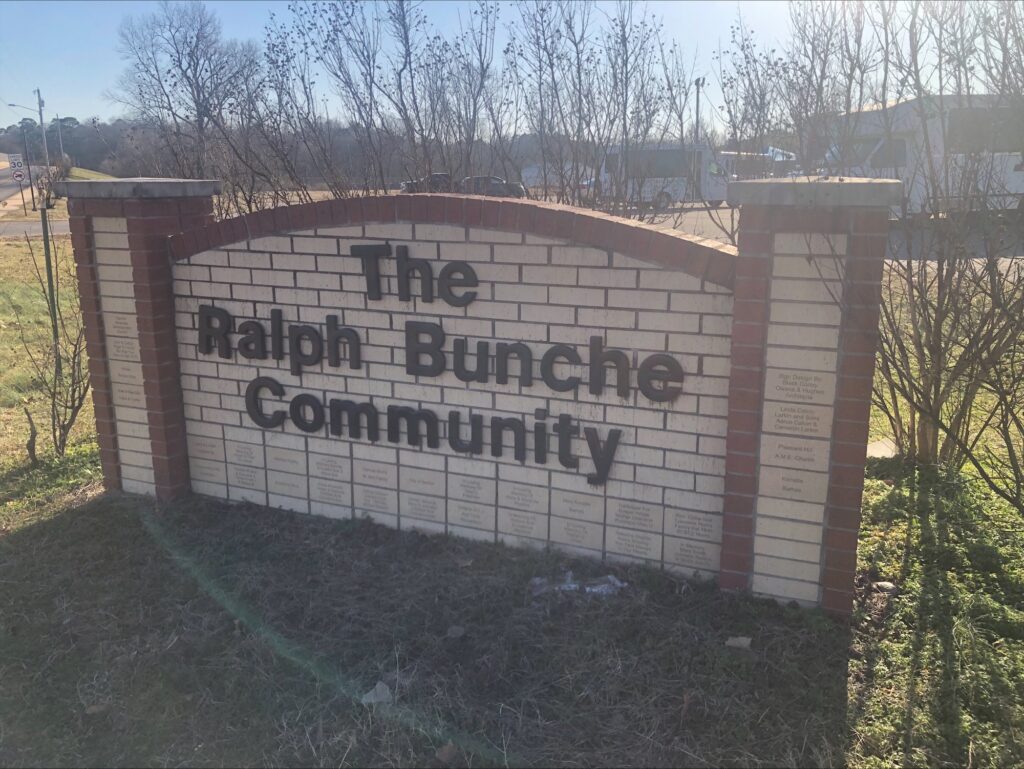Benton’s Ralph Bunche Community
By Cody Berry
Saline County’s African American community has longstanding history. Since the county was founded in 1835, there have been people of color living here who were member of both free and enslaved families. In 1838, there were 416 slaves and two free black citizens living in Saline County. By 1860, there were 749 slaves and in 1870, during Reconstruction, there were only 57 black residents living in Saline Township. In 1880, there were 142 who had last names that are still around today.1

Today, the neighborhood where some of Benton’s first African American residents settled is known as the Ralph Bunche Community. Bunche was not a resident of Saline County, but he was the first black Nobel Prize winner in 1950. Bunche arranged a ceasefire between Israelis and Arabs after the creation of the state of Israel in 1948.2
The founders of the Ralph Bunche Community were members of the Rhinehart, Canady, and Tyson families, who moved there in 1894. That year, the Rhinehart’s purchased land on the western end of Palm Street in Benton. Burl Rhinehart married Lola Canady, and they had seven children, four boys and three girls. W. A. “Wes” Ashley purchased more land in that area from former Benton mayor David Madison Cloud in 1904. Ashley’s home was built there in 1907 and remains one of the community’s oldest homes.3
In 1919, Annie Little Johnson moved to Benton to be with her brother who was working in the bauxite mining industry. Johnson worked with Benton mayor Henry Finkbeiner to raise the funds needed to bring water to the community. In addition to bauxite mining, black men of the time found work in Benton’s furniture and barrel-making mills while women worked as maids or cooks in the homes of wealthy white families like that of Robert Ashby. Annie Little Johnson was a maid for the Ashby’s for fifty years.4
In the nearby company town of Bauxite, African Americans, Mexican immigrants, and Italians lived in segregated camps. In 1920, 53 African American families and 140 single men lived in Bauxite’s Africa Camp. Homes there housed two families each, while the single men lived in one large bunk house. In 1932, Bauxite’s Mexican residents were removed to Texas and their homes in the former Mexico Camp were opened to black residents. After the Korean War ended in 1953 many former residents moved to Benton and Bryant.5
There are several churches in the Ralph Bunche Community. The oldest of which is Pleasant Hill African Methodist Episcopal Church which was founded in 1897. It’s current building at 302 Reed Street was dedicated on August 25, 1901; St. Paul Missionary Baptist was founded soon after Pleasant Hill. The current St. Paul’s building was dedicated on September 25, 1909. After that came the Elect Temple Church in 1928, Mount Zion MBC in 1933, and Johnson Street Church of Christ in 1954.
Next week, I’ll be writing about the late Charles Cunningham and his service to the City of Benton.
Citations:
1 Cody Lynn Berry, “Gravel Hill (Saline County),” CALS Encyclopedia of Arkansas, https://encyclopediaofarkansas.net/entries/gravel-hill-saline-county-12728/, Date Accessed 1/25/2025.
2 The Nobel Prize, “Ralph Bunche Facts,” https://www.nobelprize.org/prizes/peace/1950/bunche/facts/, Date Accessed 2/6/2025.
3 Cody Lynn Berry, “Gravel Hill (Saline County),” CALS Encyclopedia of Arkansas, https://encyclopediaofarkansas.net/entries/gravel-hill-saline-county-12728/, Date Accessed 1/25/2025.
4 Cody Lynn Berry, “Gravel Hill (Saline County),” CALS Encyclopedia of Arkansas, https://encyclopediaofarkansas.net/entries/gravel-hill-saline-county-12728/, Date Accessed 1/25/2025.
5 Cody Lynn Berry, “Gravel Hill (Saline County),” CALS Encyclopedia of Arkansas, https://encyclopediaofarkansas.net/entries/gravel-hill-saline-county-12728/, Date Accessed 1/25/2025.
